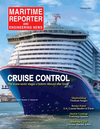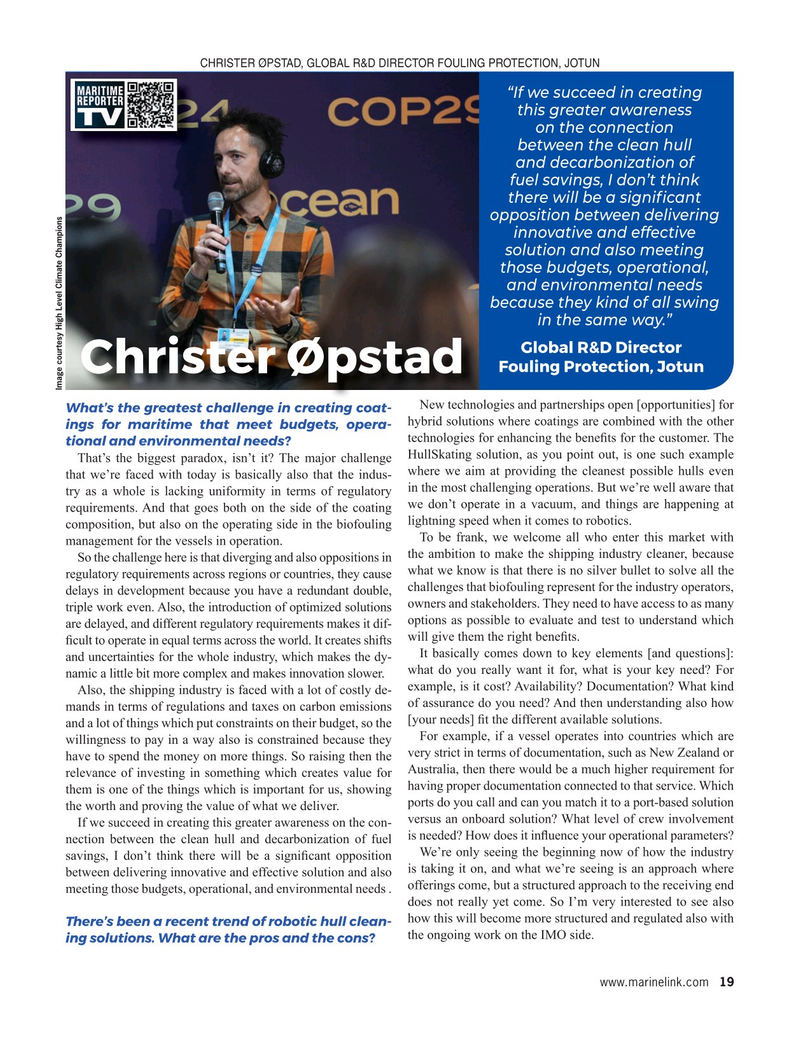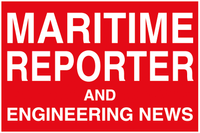
Page 19: of Maritime Reporter Magazine (February 2025)
Read this page in Pdf, Flash or Html5 edition of February 2025 Maritime Reporter Magazine
CHRISTER ØPSTAD, GLOBAL R&D DIRECTOR FOULING PROTECTION, JOTUN “If we succeed in creating this greater awareness on the connection between the clean hull and decarbonization of fuel savings, I don’t think there will be a signi? cant opposition between delivering innovative and effective solution and also meeting those budgets, operational, and environmental needs because they kind of all swing in the same way.”
Global R&D Director
Fouling Protection, Jotun
Christer Øpstad
Image courtesy High Level Climate Champions
New technologies and partnerships open [opportunities] for
What’s the greatest challenge in creating coat- hybrid solutions where coatings are combined with the other ings for maritime that meet budgets, opera- technologies for enhancing the bene? ts for the customer. The tional and environmental needs?
That’s the biggest paradox, isn’t it? The major challenge HullSkating solution, as you point out, is one such example where we aim at providing the cleanest possible hulls even that we’re faced with today is basically also that the indus- try as a whole is lacking uniformity in terms of regulatory in the most challenging operations. But we’re well aware that requirements. And that goes both on the side of the coating we don’t operate in a vacuum, and things are happening at composition, but also on the operating side in the biofouling lightning speed when it comes to robotics.
To be frank, we welcome all who enter this market with management for the vessels in operation.
the ambition to make the shipping industry cleaner, because
So the challenge here is that diverging and also oppositions in regulatory requirements across regions or countries, they cause what we know is that there is no silver bullet to solve all the delays in development because you have a redundant double, challenges that biofouling represent for the industry operators, triple work even. Also, the introduction of optimized solutions owners and stakeholders. They need to have access to as many options as possible to evaluate and test to understand which are delayed, and different regulatory requirements makes it dif- will give them the right bene? ts.
? cult to operate in equal terms across the world. It creates shifts
It basically comes down to key elements [and questions]: and uncertainties for the whole industry, which makes the dy- what do you really want it for, what is your key need? For namic a little bit more complex and makes innovation slower. example, is it cost? Availability? Documentation? What kind
Also, the shipping industry is faced with a lot of costly de- mands in terms of regulations and taxes on carbon emissions of assurance do you need? And then understanding also how [your needs] ? t the different available solutions.
and a lot of things which put constraints on their budget, so the
For example, if a vessel operates into countries which are willingness to pay in a way also is constrained because they have to spend the money on more things. So raising then the very strict in terms of documentation, such as New Zealand or relevance of investing in something which creates value for Australia, then there would be a much higher requirement for them is one of the things which is important for us, showing having proper documentation connected to that service. Which ports do you call and can you match it to a port-based solution the worth and proving the value of what we deliver. versus an onboard solution? What level of crew involvement
If we succeed in creating this greater awareness on the con- nection between the clean hull and decarbonization of fuel is needed? How does it in? uence your operational parameters?
We’re only seeing the beginning now of how the industry savings, I don’t think there will be a signi? cant opposition between delivering innovative and effective solution and also is taking it on, and what we’re seeing is an approach where offerings come, but a structured approach to the receiving end meeting those budgets, operational, and environmental needs .
does not really yet come. So I’m very interested to see also how this will become more structured and regulated also with
There’s been a recent trend of robotic hull clean- the ongoing work on the IMO side.
ing solutions. What are the pros and the cons?
www.marinelink.com 19
MR #2 (18-33).indd 19 1/28/2025 9:45:27 AM

 18
18

 20
20
